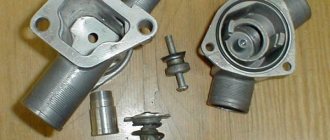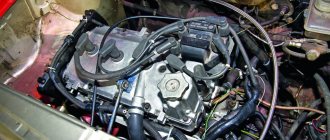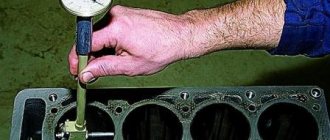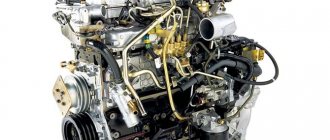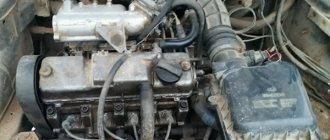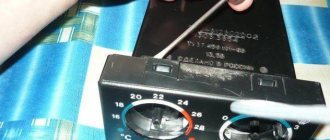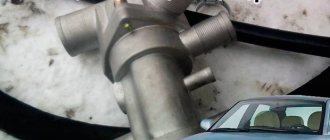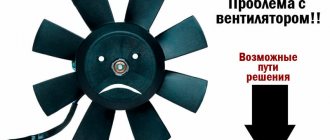How to install a plug in the engine block on a VAZ 2110
But I still think that if you bend it inward (for example, with a chisel and hammer, hit the center of the plug)... then it will bend.
and the cut will move away from the block. great advice
I'd screw in the screw and try to pull it
Well, I agree, you can pull a couple of stacks, but how to pull out the plug and what does that have to do with the self-tapping screw?
I can assume that it is new. It doesn't sit there so tightly and it's easy to take it out.
This is exactly what I'm afraid of.
And by the way, I’ll add that for some reason my first question was how to remove the old one. Now I’ve started scratching my head about installing a new plug. If I solve the first problem, then how to insert another plug? Carefully score?
They removed the camshaft sprocket and removed the shield. Gently tap the old plug with a chisel on one edge - the other one begins to come out. We pull it out flat. We go to the store with the old one and ask for heels, choose the one that is the most even and closest in diameter to the old one. We put it in place without distortion - we hammer it through a wooden block/spacer. Do not sink deeper than the edges of the block. No sealant or chemicals were used.
Something unpleasant happened. I drove with red (rusty) antifreeze. The plug on the cylinder block, the one located under the timing belt cover, has rusted. Antifreeze flowed like a stream. The plug needs to be replaced. How to remove the old one?
If you are talking about a plug next to the pump, see fig.
then if it is rusted through and through, then insert a hook made of hard wire into the hole and pull; if not (there are many small holes), then tighten the self-tapping screw and pull it out by its head with a nail puller or pliers. I don’t recommend hammering it inside, as was advised here; if it fails, then there will be big problems.
Source
How to remove the old plug
Even though the plug is screwed into a thread and has a hole for a hexagon, this does not mean that it will come out very easily. This is explained by the fact that, firstly, the thread of the plug is conical. Secondly, there is corrosion and various deposits inside the cylinder head. Therefore, here we will consider the worst case scenario, when the plug simply does not want to be unscrewed with a hexagon. I will give a method for removing the plug
, described by forum member wspace.
So, for this you will need several 3-4 mm drills (several because they often break, it is better to immediately take a spare), a jigsaw file or any other with a small tooth. How to remove the block head plug
So, take a drill or screwdriver and drill holes around the perimeter of the plug, without touching the thread (the drill is approximately in the center of the rim). You can drill straight through without fear; under the plug at a distance there is a fairly thick wall. Then use a screwdriver or whatever you need to completely break out the hexagon inside the plug. This is necessary for our file to fit through. Now we use a file to cut out the sector of the plug almost to the thread.
and inserting a screwdriver inside and prying it off, we break it out. After this, you can try to unscrew the plug. You can first try to bend it by hitting it perpendicular to the broken piece. You can also make more cuts and break out the plug piece by piece. This is a creative matter, but the meaning is clear. The main thing is not to damage the threads in the head.
Replacing the engine block plug
Simply put, cylinder block plugs are needed so that if the coolant in the engine cooling system freezes, the cylinder block itself does not burst. The fact is that the transformation of the coolant, which is located in the cooling jacket, into ice, leads to the fact that the icy liquid expands. This causes overstressing of the block and can lead to cracks.
Also, during vehicle operation, a situation often arises when coolant flows through the plugs. You can often find that the block plugs are rusty, that is, they are destroyed due to corrosion. In one case or another, these elements need to be replaced. Next we will look at how to change the engine block plugs.
How to change the plug on the VAZ 2110 block
To put it simply, engine block plugs are necessary to ensure that when the antifreeze in the engine cooling system freezes, the engine block does not break. There is a fact that the conversion of the coolant in the cooling jacket into ice causes the ice liquid to expand. This causes the device to overload and crack.
In addition, when using a vehicle, a situation often arises when coolant leaks through plugs. It is often possible to discover that the block plugs are rusty, in other words, they are destroyed due to corrosion. Regarding the fact that otherwise the specified elements must be replaced. Next we will look at how to change the forks of the engine block.
The first question is that the problem of antifreeze leakage through plugs is more common on older Russian cars. But this malfunction is not avoided by various foreign cars. To restore the tightness of the cooling system when, if antifreeze, as it is called, antifreeze is leaking through the block within the block, the marked tube must be replaced. This change should be taken into account using the example of a VAZ car.
Antifreeze or antifreeze flows through the plug: replacing the plug in the engine block with your own hands
Let's start with the fact that the problem of coolant leaking through plugs is most common on older domestic cars. However, this malfunction does not bypass various foreign cars. To restore tightness to the cooling system if antifreeze or antifreeze flows through a plug in the block, the specified plug must be replaced. Let's look at such a replacement using the example of a VAZ car.
So, the plug (cup plug of the engine block) is installed in six places. The five larger plugs are 40mm in diameter, and the slightly smaller one is 25mm in diameter. The plugs must be changed in a certain sequence.
Before replacing, in addition to the new plugs themselves, you need to prepare:
At the very beginning, you need to remove the negative voltage from the battery. Then the coolant must be drained from the cylinder block and cooling radiator. It is also important to determine in advance whether access is available in case of problems with only one cylinder block plug. If access is difficult, in some cases the cylinder head will have to be removed.
Next, the timing belt protection is removed, then you need to remove the belt and tension roller, after which the cylinder head mounting bolts are unscrewed and the head is removed. After access to the block plug is secured, a chisel is placed on the edge of the plug, which should be gently tapped with a hammer.
The plug should rotate in the cylinder block. After turning has occurred, you can then try to turn the plug with a screwdriver. After this, the element must be pryed with pliers and removed from the mounting socket.
After the block plug has been removed, the edges of the hole in the BC should be treated with sandpaper to prevent rust. To improve the tightness, the edges of the new plug can be coated with sealant before installation. At the end of this procedure, using a mandrel and a hammer, a new plug is pressed into the hole in the block.
Now you can begin replacing the remaining plugs or reassembling. If the head has been removed, you need to take into account all the features of installing and covering the cylinder head, be sure to replace the cylinder head gasket, correctly align the timing belt to the marks, adjust the ignition, etc.
We also note that on many engines, replacing individual plugs (for example, small diameter ones) involves disassembling the internal combustion engine, removing the gearbox, etc. Once the source of coolant leakage from the block has been accurately determined and the plug has been identified as the culprit, it is necessary to take into account all possible difficulties and nuances in providing access to the problem area.
How to install the ignition
- There are marks on the flywheel and the scale of the crankcase hatch, which are used to set the top dead center. The rubber plug installed on the crankcase hatch is removed. As it rotates, the crankshaft rotates until the marks on the flywheel coincide with the middle mark on the hatch body. In this case, the pistons of the fourth and first cylinders are in the top dead center position.
- Wires are connected to the carburetor, ignition distributor, spark plugs and other sensors.
- An air filter is installed.
- The cooling system is filled with antifreeze or water.
- The negative wire is connected to the battery.
- The operation of the car engine is checked.
This is a brief instruction on how to replace the plug yourself.
Tip: In order to replace a small plug or a large plug on the flywheel side on the cylinder block, you need to disassemble the car engine.
Making plugs
There are times when it is not possible to purchase new parts, or when the price of a new one exceeds its production. Typically, at the factory, the plug is manufactured in large batches using the cold stamping method by extruding from a metal sheet of the appropriate thickness, followed by cutting along the contour. For individual designs, it is better to use round stock of the appropriate diameter, and machine a disc five millimeters thick from it. Carefully adjust it to the diameter of the mounting diameter, coat it with glue and insert it into the hole, which must first be thoroughly cleaned and degreased. How to replace the plugs is clearly seen in the video. According to statistics, fluid leaks from the engine cylinder block or a faulty cooling system cause the most mechanical breakdowns of cars on the roads. High temperatures in the cooling system lead to contamination of the internal walls of the system from the formation of scale, which clogs the channels of the cylinder block and cooling radiator, which contributes to engine overheating. As a result, the engine fails.
Simply put, cylinder block plugs are needed so that if the coolant in the engine cooling system freezes, the cylinder block itself does not burst. The fact is that the transformation of the coolant, which is located in the cooling jacket, into ice, leads to the fact that the icy liquid expands. This causes overstressing of the block and can lead to cracks.
Also, during vehicle operation, a situation often arises when coolant flows through the plugs. You can often find that the block plugs are rusty, that is, they are destroyed due to corrosion. In one case or another, these elements need to be replaced. Next we will look at how to change the engine block plugs.
Read in this article
How to make a block plug yourself
Please note that the required cylinder block plugs are not always available in auto parts stores or car markets. It often happens that the cost of such a simple part may actually turn out to be too high. For this reason, some car owners prefer to make a block plug with their own hands.
Then the disk is carefully adjusted to the seating dimensions, coated with sealant, and then pressed into the hole in the cylinder block, previously cleaned of rust and degreased, using the method described above.
Let's sum it up
It is well known that overheating is one of the most common reasons why an internal combustion engine can be seriously damaged or fail completely. At the same time, repair and restoration of an overheated internal combustion engine turn out to be very costly operations in practice; sometimes it is necessary to replace the engine with a contract engine, etc.
At the same time, the efficiency of the cooling system directly depends on the quality and condition of the coolant, its level, as well as the cleanliness of the channels of this system themselves. In order to avoid problems with corrosion, get rid of the formation of scale and deposits, and also eliminate the risk that the liquid in the cooling system will freeze in winter, you need to use special coolants. Otherwise, the thermostat may quickly begin to work incorrectly, the pump impeller will be damaged, etc.
Replacement procedure
First of all, you need to make the area in which the stub is located accessible. To do this, follow these steps (in this order):
- Disconnecting the exhaust pipes of the muffler from the exhaust manifold.
- Removing the bracket on which the pump pipe for supplying coolant is fixed.
- Disconnecting the hoses that provide ventilation to the unit from the carburetor and cylinder head cover. Closing the carburetor with a special cover.
- Removing the air filter.
- Disconnecting the wires from the carburetor, ignition distribution sensor, spark plugs.
- Removing the sensor that distributes the ignition.
- Disconnecting hoses from the fuel pump, outlet pipe, vacuum brake booster.
- Disconnecting the air and throttle valve drive cables.
- Removing the toothed belt protective cover.
- Removing the pulley with key.
- Removing the cylinder head.
Direct replacement of the plug includes the following:
- Rotating the plug into the cylinder head using a chisel and hammer.
- Pry the plug with pliers and remove it. If the part is very rusty and does not turn, you need to make a hole, screw a knob into it and pull out the plug.
- Cleaning the edges of the cylinder head hole from corrosion using sandpaper. Lubricating the edges of the new part with a sealing agent.
- Pressing the part into the cylinder head hole using a mandrel and a hammer.
How to replace engine plugs
Plugs are plugs that are expanded by the impact of a striker after being installed in the hole. Perhaps this information will be useful to you when purchasing.
How to find stubs
Two cup-shaped plugs are located in the engine block, under the manifold mounting points.
The plugs are located in various places in the cylinder block and cylinder head.
They cover the holes formed during the casting of these parts.
The plug is a weak point that, if overheated or frozen, can be damaged by the pressure of expanded coolant. If there were no plugs, the engine housing would crack at such moments.
Types of Stubs
The dome-shaped plugs are inserted all the way into the collar. Cup-shaped plugs are recessed inside so that the rim extends slightly beyond the recess.
In most cases, the plugs are located: on the side surface of the block, under the manifold; inside the clutch housing or above it, in close proximity to the transverse partition; at the top of the cylinder head, under the overhead camshaft.
Sometimes the plugs fly out completely, causing a sudden loss of coolant. In addition, liquid may leak little by little through the rusted edges. Small leaks leave marks on the block. Examine the block to find them.
Some plugs are hidden from the naked eye. Use a mirror to look into hard-to-reach places, such as behind a block. Remember that plugs come in different sizes, so measure the holes you need before purchasing.
It is possible that to gain access to the plugs you will have to remove the carburetor.
In some cases, in order to change the plugs on the bulkhead side, it is necessary to remove the entire engine. It is better to entrust this procedure to specialists.
Do not try to make a hole in the partition. This is a load-bearing structure, and if the hole is not repaired, the vehicle's warranty may be void. A simple rivet is unlikely to satisfy the insurance company.
Disconnect the battery and drain the cylinder block. If you plan to reuse the fluid, collect it in a clean container (see How to Flush an Engine Radiator).
Before pouring, strain the liquid through a thin cloth. Check the concentration of the solution (see section Checking and adding antifreeze).
There are two types of plugs - cup-shaped and dome-shaped. The installation methods for such plugs are different.
How to remove the plug
The cup-shaped plug can be pulled out with two pairs of pliers.
Plugs of any type are removed using a thin screwdriver. Use a blade to pierce the center of the plug and pull it out.
Remember that the movement must be uniform. Otherwise, the plug will become skewed and get stuck.
Use a screwdriver to pierce the old plug and pull it out.
In some cases, the edges of the cup-shaped plug stick out quite a bit and can be grabbed with two pairs of pliers. When pulling out the plug, apply equal force on both sides. Do not try to use the screwdriver as a lever and rest it on the block, so as not to damage the groove itself.
Remove any remaining old caulk with a wooden tool.
How to replace the plug
Use the correct size holder to install the cup plug.
Lubricate the plug and hole with sealant.
Insert the dome plug with the dome facing out. Make sure it is not skewed. Tap the center of the plug with a striker to expand it. The plug must fit firmly into the hole.
Use the striker to install the domed plug.
To install the cup plug, find a holder that fits snugly into the cup. Place the plug at right angles to the hole and then hit the holder with a soft hammer.
Make sure that the plug does not bend and remember that its edges should protrude slightly beyond the hole. This will make it easier for you to remove the plug if necessary.
On some older BL series engines, the plugs in the engine base plate are installed using a bolt.
In some designs there is simply no place to swing a hammer to install the plug. For example, on Leyland B engines the dome plugs, hidden by the base plate, are directly opposite the baffle, but there are special holes in the base plate.
Insert a new plug, insert a 50 mm long bolt into the hole, put a nut on it and tighten it a little to press the plug into the groove.
This method is also used for other problem areas.
How to remove the plug
The cup-shaped plug can be pulled out with two pairs of pliers.
Plugs of any type are removed using a thin screwdriver. Use a blade to pierce the center of the plug and pull it out.
Remember that the movement must be uniform. Otherwise, the plug will become skewed and get stuck.
Use a screwdriver to pierce the old plug and pull it out.
In some cases, the edges of the cup-shaped plug stick out quite a bit and can be grabbed with two pairs of pliers. When pulling out the plug, apply equal force on both sides. Do not try to use the screwdriver as a lever and rest it on the block, so as not to damage the groove itself.
Remove any remaining old caulk with a wooden tool.
Replacing the resonator
Resonator VAZ 2110
- The resonator is attached to the muffler using a crimp clamp with an O-ring;
- It is attached to the neutralizer by means of a floating flange (two bolts) and flaring;
- On the opposite side of the neutralizer there is a “fist”;
- It is often problematic to unscrew the knuckle mounting bolts; they are simply cut off with a grinder and replaced with new ones;
- If suddenly you don’t have a tool at hand, we clean the places where the bolts are attached and treat them with a “liquid wrench” (WD-40 or its equivalent);
- Unscrew the bolts and remove the muffler clamp;
- We remove the resonator from the suspension rubber bands, change the rubber bands if necessary;
- Then we hook a new resonator onto rubber bands and attach it to the muffler so that the pipe running from the resonator to the muffler is parallel to the ground;
- When there is wear on the neutralizer fist or there are burrs, grooves or rust on it, it is necessary to lubricate the connection with a special high-temperature sealant;
- Using new bolts and nuts, tighten the flanges of the catalyst and resonator;
- The neutralizer is attached to the resonator by means of a flange connection (two bolts), to the receiving pipe (pants) by means of a spring-loaded connection and a pair of flares, between which there is a graphite or metal-asbestos ring.
VAZ 2110: replacing the muffler with your own hands - instructions | MasteraVAZa
Exhaust system VAZ 2110
Replacing a muffler for a VAZ 2110 or its parts is not work that needs to be done systematically. It is not necessary to change parts of the exhaust system often, in cases where the muffler begins to make noise, its elements burn out, or in the event of a break in the connecting pipes. You can change any part of the muffler with your own hands. The VAZ 2110 exhaust system consists of a reception pipe (another name for pants), a neutralizer, a resonator (additional muffler), and a main muffler.
How to replace a muffler on a VAZ 2110
We are changing the muffler of the VAZ 2110, the replacement is made in the inspection hole:
- The muffler is connected to the resonator through an o-ring, which is installed in the pipe flare and compressed with a clamp that folds in two halves
- We remove the clamp, then the ring, it is graphite and does not stick to the metal.
Attaching the muffler to the resonator
- Removing the old muffler
- We check the condition of the suspension rubber bands located on the sides of the muffler body. If they have cracks or are stretched, they should be replaced.
VAZ 2110 muffler suspension rubber band
- We install a new muffler, first on the rubber bands, then insert a graphite ring (preferably a new one) between the flares and compress it with a clamp.
So we replaced the muffler on the VAZ 2110, replacing the resonator is the next step.
Replacing the resonator
Resonator VAZ 2110
- The resonator is attached to the muffler using a crimp clamp with an O-ring;
- It is attached to the neutralizer by means of a floating flange (two bolts) and flaring;
- On the opposite side of the neutralizer there is a “fist”;
- It is often problematic to unscrew the knuckle mounting bolts; they are simply cut off with a grinder and replaced with new ones;
- If suddenly you don’t have a tool at hand, we clean the places where the bolts are attached and treat them with a “liquid wrench” (WD-40 or its equivalent);
- Unscrew the bolts and remove the muffler clamp;
- We remove the resonator from the suspension rubber bands, change the rubber bands if necessary;
- Then we hook a new resonator onto rubber bands and attach it to the muffler so that the pipe running from the resonator to the muffler is parallel to the ground;
- When there is wear on the neutralizer fist or there are burrs, grooves or rust on it, it is necessary to lubricate the connection with a special high-temperature sealant;
- Using new bolts and nuts, tighten the flanges of the catalyst and resonator;
- The neutralizer is attached to the resonator by means of a flange connection (two bolts), to the receiving pipe (pants) by means of a spring-loaded connection and a pair of flares, between which there is a graphite or metal-asbestos ring.
7.2. Removing and installing cylinder block plugs
Rice. 67. Front part of the cylinder block: 1 — spring tension pin; 2 — chain guide support pin; 3 — steel ball with a diameter of 17 mm; 4 - oil spray nozzle; 5 — cylinder block plug; 6 — support pin of the chain tensioner shoe; 7 — support pin of the oil pump drive chain tensioner
Rice. 66. Rear part of the cylinder block indicating the location of the steel ball (1) blocking the main oil line and the plug (2) of the cylinder block
There are hole plugs installed on the sides and ends of the cylinder block, which are squeezed out of the block if the coolant freezes. On the side of the coolant drain plug on the cylinder block there are two plugs with a diameter of 34 mm, and on the opposite side (on the oil filter side) there are two more plugs of the same diameter. On the end side of the crankcase there is one plug 5 (see Fig. 67) with a diameter of 17 mm. Another plug 2 (see Fig. 66) with a diameter of 34 mm is pressed into the front end side of the cylinder block. These plugs can be changed if the coolant freezes without removing the engine, but using a special tool. To do this, you must perform the following operations:
— drain the coolant;
— remove parts and assemblies that may interfere with access to the plugs;
Rice. 69. Installing a screwdriver or chisel to remove cylinder block plugs
Rice. 70. Removing the plug from the block
— place a narrow chisel or a powerful screwdriver under the edge of the plug (Fig. 69) and use a hammer to turn the plug in the hole 90° around its axis (Fig. 70);
- grab the plug with pipe pliers and pull it out of the cylinder block, as shown in Fig. 70;
— Thoroughly clean the mounting hole of the plug in the cylinder block. There should be no traces of grease left on the sealing surface;
- coat the mounting hole with Loctite fixing agent and insert a new plug using a special mandrel (specification number 00) or another suitable mandrel so that it is flush with the surface of the cylinder block;
— install all the removed parts in their places and after a pause of 45 minutes, pour coolant into the engine if it was not removed from the car;
— after that, start the engine and check it for leaks.
| previous page2.7.1. general description | next page 2.7.3. Measuring the working clearance in the pistons |
How to remove the old plug
Even though the plug is screwed into a thread and has a hole for a hexagon, this does not mean that it will come out very easily. This is explained by the fact that, firstly, the thread of the plug is conical. Secondly, there is corrosion and various deposits inside the cylinder head. Therefore, here we will consider the worst case scenario, when the plug simply does not want to be unscrewed with a hexagon. I will give a method for removing the plug
, described by forum member wspace.
So, for this you will need several 3-4 mm drills (several because they often break, it is better to immediately take a spare), a jigsaw file or any other with a small tooth. How to remove the block head plug
So, take a drill or screwdriver and drill holes around the perimeter of the plug, without touching the thread (the drill is approximately in the center of the rim). You can drill straight through without fear; under the plug at a distance there is a fairly thick wall. Then use a screwdriver or whatever you need to completely break out the hexagon inside the plug. This is necessary for our file to fit through. Now we use a file to cut out the sector of the plug almost to the thread.
and inserting a screwdriver inside and prying it off, we break it out. After this, you can try to unscrew the plug. You can first try to bend it by hitting it perpendicular to the broken piece. You can also make more cuts and break out the plug piece by piece. This is a creative matter, but the meaning is clear. The main thing is not to damage the threads in the head.
Replacing the cylinder block plug of a VAZ 2110
VAZ - Blank plug for VAZ block. Lada Niva Replacement of aluminum head plug for VAZ 21011. Lada Samara Repair of cylinder head for VAZ 2110. etc. Washing injectors (cleaning the injector).
Replacing the VAZ 2110 engine mount. 0 0 443. Do it yourself At home - how to make an arc reactor. Replacing front springs on a VAZ. 0 0 125. Replacement of corrugation for Opel. Saint Petersburg.
Replacing cylinder block plugs. Do it yourself! . Remon | VAZ 2109-08 Replacing the cylinder block plug.
Lada 21099 Brunette › Logbook › Replacing the cup plug of the cylinder block. 23 years old I drive a Lada 2110 Zavolzhye, Russia.
Replacement of the plug in the VAZ-21083 cylinder block and modifications based on block 21083. Replacement of the VAZ 2110 heater radiator.
Repair of the VAZ 2110 stove (heater). We eliminate creaks and rattles in the door trims of the VAZ 2110. Eliminate oil leaks from under the cylinder head plug from the my2110.ru forum. Interesting photo reports: Replacing the gearbox ball joint race.
Replacing the oil seals of the 16 valve VAZ 2110 2111 2112 engine. On the VAZ-2111 engine, using a “10” wrench, unscrew the two nuts securing the “mass” wires to the studs of the cylinder head plug
Avto-mechs.ru » Video gallery » Video do-it-yourself auto repair: Leaking cylinder block plugs for VAZ-2109 plugs for Free videos on how to put a timing belt on a scooter. replacement of hub bearing for VAZ 2109. Opel Astra N 1.3 diesel spare parts.
Cylinder head parts: 1 – cylinder head; 2 – intake 1. Remove the cylinder head from the engine (see “Replacing the cylinder head gasket”). Repair, operation and installation of VAZ 2110, 2111, 2112 cars.
replacing engine plugs. VAZ cylinder block 2108-09-10. viburnum. . What will happen if you wash the engine of a VAZ 2110? Many people are afraid to wash the engine of their car, but I do it regularly, so far everything is fine!
Cooling channel plugs in the block? Topic author Arifmon, 3.5.2011, 22:22. What paint should the cylinder block be painted with? It is some kind of special heat-resistant paint or regular paint over a regular primer.
On the other side of the cylinder head we press in the plugs. We remove the timing belt (see Replacing the timing belt on VAZ-2110, -2111 engines).
How to replace the cylinder head gasket on a VAZ 2110. 5. Disconnect the exhaust pipe of the muffler from the exhaust manifold (Replacing the exhaust pipe of the muffler>>>).
► replacing engine plugs. VAZ 2108-09-10 cylinder block. Kalina. Alexander Skripchenko. It is shown how you can replace plugs (plugs) on a VAZ engine block with your own hands.
They did it, which they regretted later. We had to take it apart again. And the plug that plugs the block where the antifreeze is located rusted. We knocked it out with a chisel and a hammer, then pulled it out with Hyundai pliers. Kia. Lada (VAZ).
You dig it out in any way, you won’t damage the block, then you take the plug (it came from a VAZ-2109) and use a copper adapter without sealant or any nonsense to hammer it in so that it fits in smoothly and that’s it. December 14, 2013
A nice bonus is the presence of a mark on the flywheel, which can be seen under the rubber plug on top of the gearbox, here is a photo. Replacing the VAZ-2110 heater motor. Replacing the wheel bearing.
Install the cylinder head with the bearing housings facing up, placing wooden shims underneath to prevent damage to the valves. Repair and operation of VAZ 2110, 21102.
What to do after replacement
So, the plug has been replaced and is no longer leaking, all that remains is to return the cylinder head to its place. To do this, follow these steps:
- Cleaning the cylinder head from contaminants and formations using diesel or kerosene.
- Removing remaining coolant from threaded holes.
- Cleaning the cylinder head mating surfaces from the old gasket, degreasing them with a solvent.
- Installation of the head on the BC.
- Head fixation. The fastening bolts are immersed with threads in motor oil. When the lubricant drains (about half an hour), the head is fixed.
- Putting the belt on the crankshaft pulley.
- Tension the belt counterclockwise.
- Installation of the belt drive protective cover (the mounting bolts are not tightened). Turn the crankshaft 2 turns (the belt should be tight even when the crankshaft is stopped). Checking the alignment of the mounting marks on the camshaft pulley and the cylinder head cover. Tightening the bolts securing the tension pulley bracket.
- Installation of drive cables for carburetor flaps.
- Connecting the removed hoses.
- Installation of the ignition distribution sensor.
Now you need to set the ignition timing. To do this, do the following:
- Connecting wires to the carburetor, ignition distribution sensor.
- Installing an air filter.
- Filling the cooling complex with antifreeze/water.
- Connecting the negative cable to the battery.
- Checking the functioning of the internal combustion engine.
Antifreeze or antifreeze flows through the plug; replacing the plug in the engine block with your own hands
Let's start with the fact that the problem of coolant leaking through plugs is most common on older domestic cars. However, this malfunction does not bypass various foreign cars. To restore tightness to the cooling system if it leaks through a plug in the block, the specified plug must be replaced. Let's look at such a replacement using the example of a VAZ car.
So, the plug (cup plug of the engine block) is installed in six places. The five larger plugs are 40mm in diameter, and the slightly smaller one is 25mm in diameter. The plugs must be changed in a certain sequence.
Before replacing, in addition to the new plugs themselves, you need to prepare:
Experts, regardless of engine type and time of year, recommend using only high-quality antifreeze or antifreeze diluted with distilled water in the required proportions, but not running or even distilled water.
You also need to remember that any antifreeze has a limited service life (maximum 4 years), and mixing different types of coolant with each other is also prohibited. Also used to flush the engine cooling system.
Antifreeze or antifreeze in the cylinder block: what to do and how to solve the problem. ... As a result, the permeability of the channels deteriorates, oil circulation is disrupted, and filters quickly become unusable.
As a rule, the color of antifreeze or antifreeze in this case changes to... If you remove the oil filter, then you can also notice sticky deposits inside it. ... How to eliminate an antifreeze leak: causes and possible...
The plugs in the cylinder block are integral elements of the unit. If liquid begins to leak from the cooling system, the root cause may be plugs that have become unusable. The appearance of holes is caused by rust that forms during the operation of the car. Replacing plugs on a VAZ engine can often eliminate such problems, and installing new ones yourself does not take as much time as compared to engine repair.
How to replace the plug in the engine block of a VAZ 2109 from the passenger compartment
Category: Car repair video
Vehicle characteristics: The vehicle dimensions are as follows: body length - 3834, width - 1690, height - 1820 mm. The wheelbase is 2247 mm. Ground clearance 135 mm. The car is equipped with a hybrid power unit. The four-cylinder engine is equipped with a system that provides engine power output. There are sixteen valves per engine. The diameter of one cylinder is 83 mm, the piston stroke is 20 mm. The engine crankshaft accelerates to 7000 rpm. Maximum torque is maintained up to 8000 rpm.
Original title: Degen ty?ynyn blockta ?oz?alt?ish VAZ 2109 tarapynan salons
Release date: December 29, 2021
Posted by admin: at the request of Giovannia
Review from a car owner named Kadir: Despite the 1.2 engine, this is a very dynamic car that allows you to move effortlessly in traffic both in the city and beyond. I was especially pleased with the 6th gearbox, which allows you to accelerate even after 120 km/h (there is no need to switch to a lower gear). Over the year, the price for my equipment has increased by 50,000 p. , not a bad investment. Consumption on the highway is 6l./100 km. , city 8 l. The cost of service is borderline tolerable.
Laughter in the subject: If we take the “major repairs” column from the receipt and multiply the amount from it by the number of apartments in our entrance, then a logical question arises: - And where, in fact, are the oak parquet floors, stained glass windows and a doorman in livery, welcomingly opening the front door ?
Repair of exhaust system parts
- It is possible to weld parts of the exhaust system only if they have been damaged as a result of mechanical impact
- In the event that a pipe breaks, or a weld seam or tank burns out, you need to replace the entire element, it has already become unusable
- The only part to which this does not apply are metal expansion joints. They change regardless of the exhaust system itself
- The cost of the neutralizer in comparison with other elements of the system is decent. Therefore, many people change it to a stronger (flame arrester)
- The neutralizer is cut off, leaving only the connecting flanges, as well as a fist with flaring, and a flame arrester is welded in
- The cost of a flame arrester is much lower than a neutralizer. However, there is no afterburning of fuel residues. Therefore, its installation is permissible on cars with one lambda sensor. In addition, the flame arrester increases fuel consumption by about 10-15%.
Replacing plugs for VAZ 2110
Car owners often encounter the problem of fluid leaking from the cooling system. Often the reason lies in rusted or squeezed out plugs in the engine cylinder block. To fix the problem, just replace them with new ones.
Plug locations
- There are plugs on the sides and ends of the cylinder block that are squeezed out of the block when the coolant freezes in it.
- Two plugs with a diameter of 34 mm are located on the cylinder block on the side of the coolant drain plug, and two more on the oil filter side
- There is another plug with a diameter of 17 millimeters on the rear end side of the crankcase
- The last plug with a diameter of 34 mm is located at the front end of the cylinder block
These plugs are changed if the coolant in the cylinder block is frozen. The plugs can be changed without removing the engine. On a VAZ 2110, replacing the cylinder block plugs is done using a special tool. To do this you will need:
- beard or chisel
- hammer
- pliers
- durable screwdriver
- telescopic magnetic pointer (purchased at any automotive store)
- new plug
- sealant
- skin
